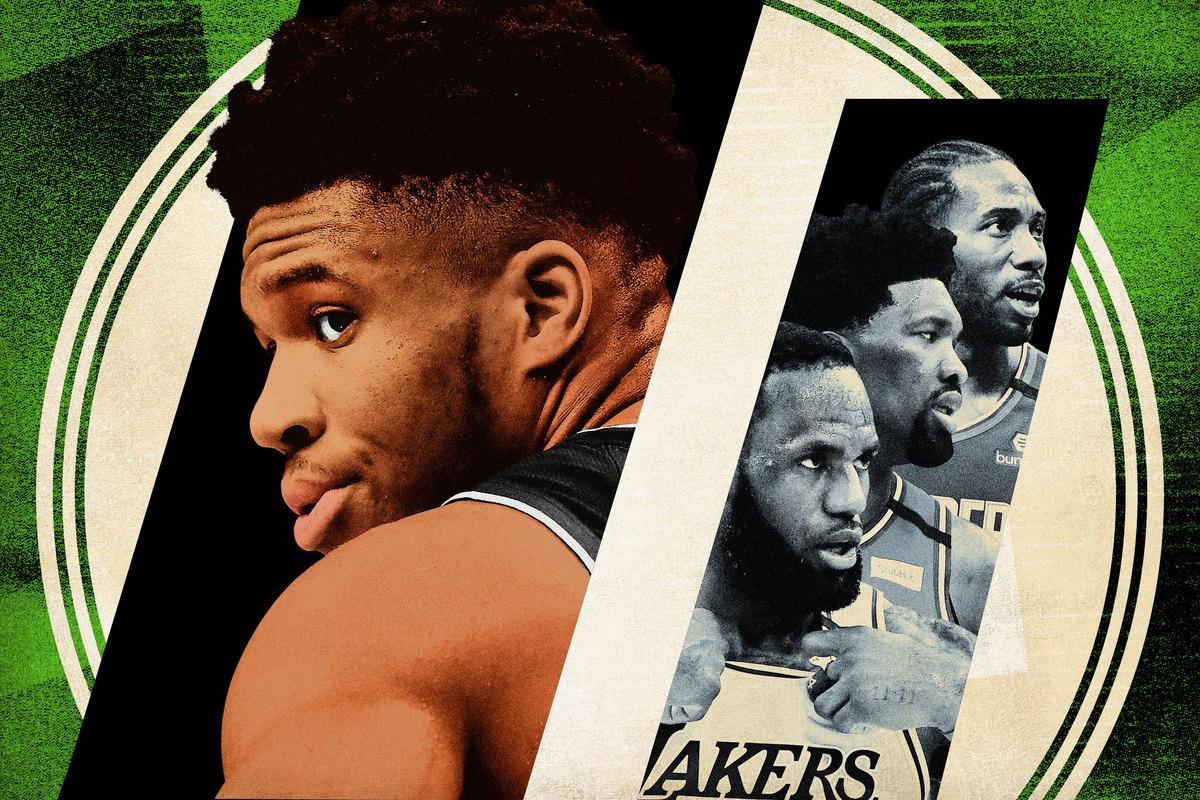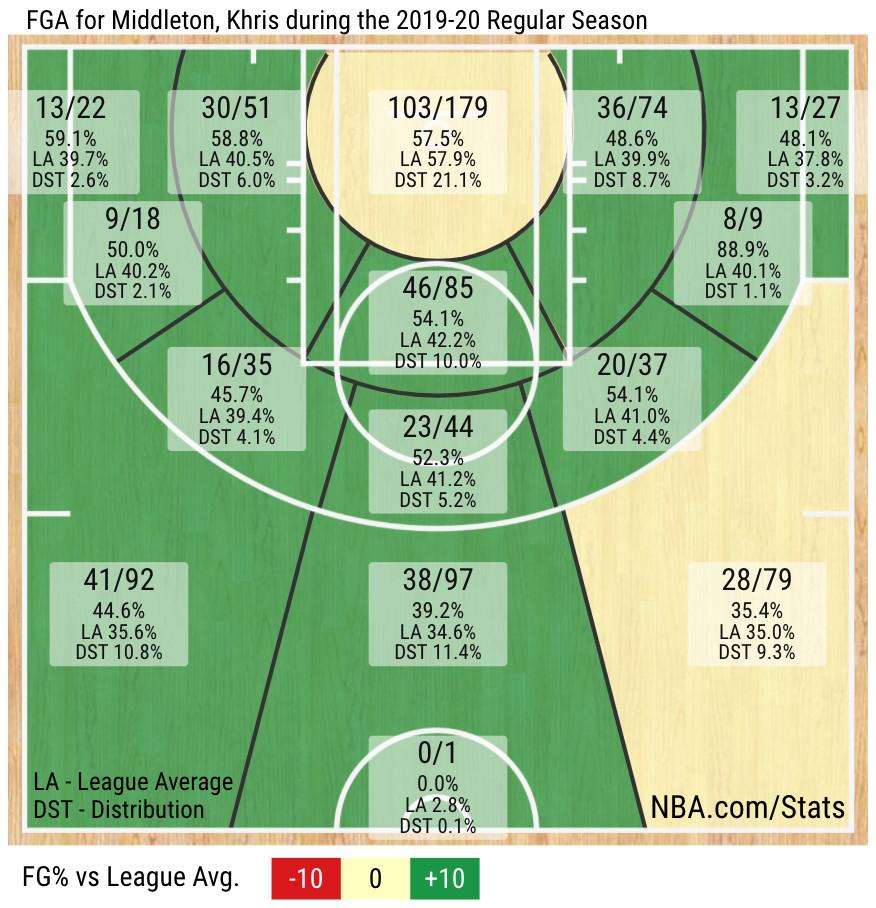
The Milwaukee Bucks are not favored by sportsbooks to win the NBA title this season; that would be the Lakers or Clippers, depending on the provider, with the Bucks second or third. But despite all the starpower in L.A., that assessment sells the Bucks short: They should be the favorites.
In looking at statistical models rather than Vegas odds, the Bucks indeed register not only as the top title contender, but as a heavy favorite. ESPN’s BPI model (not yet updated for the new schedule) gives them a 59 percent chance to lift the trophy; Basketball-Reference (ditto) pegs them with 51 percent odds; ESPN’s Kevin Pelton, after updating for the new format, has them at 43 percent. No other team in any of those three models boasts better than 20 percent championship odds. The Ringer hasn’t unveiled full playoff odds yet, but we’d outline a similar range for both the Bucks and their closest competitors.
To be fair, Milwaukee isn’t a unanimous favorite by the numbers; FiveThirtyEight’s model follows Vegas’s lead, in large part because it thinks the 76ers are better than the Bucks. And of course, the unprecedented strangeness of the prospective 2020 postseason means more uncertainty about how players will respond, and whether illness and injury could wield an even greater impact on playoff results than usual.
But the Bucks are still the team to beat in any scenario, and if the NBA successfully restarts amid a pandemic, here are 10 reasons why they’re the most likely team to win.
1. They have Giannis Antetokounmpo.
Let’s start with a simple one. Giannis is the presumptive MVP for the second consecutive season, and his early-March knee sprain—which cost him two games, both Bucks losses, before the season’s postponement—is now a relic of a different time. That’s a pretty good foundation for a title run.
2. They’re going to be a no. 1 seed.
More than any other major American sports league, the NBA tilts top-heavy in the playoffs. More than 70 percent of champions in the shot clock era (since 1954-55) have been no. 1 seeds.
NBA Playoff Performance by Seed in the Shot-Clock Era
The Lakers, of course, are a (very likely) no. 1 seed, too, and the top seeds’ traditional advantage will be somewhat diluted this season without home games. However, hosting home games isn’t the main reason higher-seeded teams advance more often in the playoffs—it’s because they’re better, period, at home or on a neutral court in Orlando.
3. They’re a historically dominant regular-season team.
The Bucks aren’t merely a regular top-seeded team, however. They’re one of the best regular-season teams in league history—and, crucially, that kind of extreme performance has been quite predictive of playoff success. Out of 11 previous teams that posted the point differential of a 65-win season or better—as the Bucks are currently on pace to do—eight won a title, and a ninth lost to another team on the list.
Best NBA Seasons by Point Differential
4. Their defense is also historically dominant.
More historic accomplishments! Adjusted for the overall scoring environment, the Bucks have the third-best defense on record, allowing 8.5 fewer points per 100 possessions than the league average. When I wrote this piece in February, the Bucks ranked fourth on that list; now they’re up a spot, with potentially another team to pass depending on how hard they try in the eight “seeding games” before the playoffs begin.
It’s unclear how the midseason delay will affect play in Orlando, but based on previous long layoffs, it’s reasonable to figure that offenses may look sloppy in the games to come; after the 1999 lockout, for instance, scoring dropped to its lowest mark in the shot clock era. And if defense dominates in the 2020 postseason, the Bucks are best positioned to assert superiority on that end.
5. The Bucks didn’t underachieve in the 2018-19 postseason.
Well, sure, you might say, but the Bucks were a no. 1 seed with the league’s best defense last season, too, and that didn’t save them from losing four straight games to Toronto after taking a 2-0 lead in the conference finals. But the memory of the Bucks’ collapse shouldn’t tarnish the entirety of their playoff run last season; here are their game-by-game results before the switch flipped against Toronto:
- Won by 35
- Won by 21
- Won by 16
- Won by 23
- Lost by 22
- Won by 21
- Won by 7
- Won by 12
- Won by 25
- Won by 8
- Won by 22
That’s a 10-1 record with an astounding plus-15.3-per-game point differential. Even adding in the next four games, all losses, the Bucks still finished with by far the best net rating for any 2019 playoff team. One can reasonably criticize the Bucks for their inability to finish off the Raptors—but NBA teams from Jordan’s Bulls to the Shaq-and-Kobe Lakers to Curry’s Warriors all experienced playoff growing pains before breaking through, and last season was the Bucks’ first in the top half of the Eastern standings since Giannis arrived. They did just fine for their first postseason with all the core pieces in place.
6. They don’t have to play an L.A. team until the Finals.
Looking ahead to the 2020 postseason, one obvious advantage for the Bucks as compared to the Lakers and Clippers is an easier path to the Finals. In the East, the Bucks should bludgeon whichever team grabs the no. 8 seed, and while their potential second- and third-round opponents should pose much more formidable challenges, they’re still in for a smoother ride than the Western contenders.
The Lakers might have to go through the Pelicans, Rockets, and Clippers to reach the Finals; the Clippers might have to survive the Mavericks, Nuggets, and Lakers. Almost any assortment of Western opponents will prove tricky. It certainly helps to have to defeat only one of the other teams in the commonly accepted top tier instead of both.
7. Khris Middleton is a star.
Contrasted with other Big Twos across the league, the Bucks might seem like a one-man show—but that characterization sells Middleton short. Out of 46 qualified players this season with a usage rate of at least 25 percent, he ranks second in true shooting percentage. His is a rare combination of volume and efficiency; Middleton makes shots at an average or better rate from every spot on the floor. In this shot chart, green means he’s better than average, yellow about average, and red below average—but, spoiler alert, there’s no red to be seen.

While Giannis battles with the likes of LeBron James and Kawhi Leonard, Middleton should be able to hold his own against the elite no. 2 options on the L.A. teams. According to FiveThirtyEight’s wins above replacement stat, adjusted for minutes played, Middleton rates among the league’s best second bananas this season. (To make this chart, I removed each team’s WAR leader—its first option—and then sorted all the remaining players by WAR adjusted for playing time. So the 76ers’ “second banana” is Joel Embiid because Ben Simmons rates first on the team in WAR.)
Best Second Bananas
He can even hold his own without his star teammate on the floor. When he plays without Giannis, Middleton averages 31 points, eight rebounds, and six assists per 36 minutes; the only players approaching those numbers over the full 2019-20 season are Giannis himself, Leonard, and Luka Doncic.
And for whatever it’s worth, unlike some other key members of this Bucks team—sorry, Eric Bledsoe—Middleton is a proven playoff performer who almost single-handedly won a 7-over-2 upset against the Celtics in 2018. Overall, his per-game playoff numbers are directly in line with his regular-season numbers over the same period, and he’s made 45 percent of his postseason 3-pointers. That’s the best mark for any active player (minimum 150 attempts).
Active Postseason 3-Point Percentage (Min. 150 Attempts)
8. The Bucks have depth and lineup versatility.
Beyond Middleton, the Bucks don’t surround Giannis with stars as much as they do players who fit together in a modern NBA lineup. The rest of the rotation has two traits in common. First, they can basically all play defense; Bledsoe and Brook Lopez could join Giannis on All-Defensive teams this season. And second, they can basically all shoot: The top 12 Bucks in minutes per game this season all take at least two 3-pointers per contest.
But beyond those commonalities, the Bucks all fit different archetypes. On the wings alone, they have elite shooters in Kyle Korver and George Hill, the latter leading the league in 3-point percentage (48 percent); sturdy veterans who can shoot and defend, in Wes Matthews and midseason pickup Marvin Williams; and young role players with all-around ability, in Pat Connaughton and advanced stats darling Donte DiVincenzo. Milwaukee’s bench may not be as lustrous as the Clippers’, but it’s plenty versatile, affording coach Mike Budenholzer the option to mix and match lineups based on the situation and player form.
In other words: There’s a reason the Bucks have still been a top-10 team without Giannis on the court each of the past two seasons, per Cleaning the Glass.
Bucks’ Net Rating
The big-man rotation, meanwhile, includes the Lopez brothers and the Bucks’ greatest wrinkle: Giannis at center. Which leads to reason no. 9.
9. Budenholzer has a new wrinkle this season.
Budenholzer is an excellent regular-season coach, with a clear and effective system on both sides of the court. He led the Hawks to a franchise-record 60 wins, took the Bucks from 44 to 60 wins in his first season with the team, and had his team playing at an even higher level this season. The knock against the coach, though, is an inflexibility in the playoffs across both his Atlanta and Milwaukee tenures; last season’s Eastern Conference finals changed when Nick Nurse made mid-series strategic adjustments and Budenholzer didn’t respond.
Yet one key statistic hints that he might be ready to adapt on the fly in these playoffs. Giannis spent 213 possessions at center in the 2018-19 regular season, per CtG, and then only nine possessions—nine! total! across 15 games!—in the playoffs. This season, he’s doubled his time at center, with 418 possessions there despite the shortened season.
While Giannis still hasn’t been a primary option as the lone big—Brook Lopez has spent 3,544 possessions at center, and Robin Lopez 1,639—this increased experimentation suggests Budenholzer understands the importance of lineup variations. And this lineup in particular may be his greatest untapped resource in the postseason.
Here’s one way to conceptualize Giannis-at-center lineups. The Bucks are a phenomenal team with Brook Lopez at center, with a net rating of plus-13.1. That’s in the 98th percentile of all lineups that have played at least 100 non-garbage-time possessions, per Cleaning the Glass. Yet when Giannis plays center, the Bucks register at plus-21.7—placing them in the 100th percentile. Giannis at center gives them the best lineup in the whole league.
Much like the Steph Curry–Kevin Durant pick-and-roll, which the 2016-17 Warriors saved for the Finals, this lineup could elevate a great regular-season team to even loftier heights in the playoffs.
10. Giannis is still getting better.
The reigning MVP’s singular talents are the first and last reason that the Bucks are Finals favorites; his ability to break the game at center would represent only the newest manifestation. On offense, he’s the NBA’s best scorer in the paint; on defense, he’s the best paint defender, allowing opponents to shoot a league-low 41.8 percent at the rim. (The Lopezes rank second and fourth among all players who have defended at least 100 shots.) And Giannis doesn’t just blockade the basket when he’s the lone big defender—he also destroys pick-and-rolls because of his switchability and rates as the league’s stingiest isolation defender for good measure. Opponents have scored just 0.36 points per iso possession against him this season, according to Synergy tracking data, shooting 4-for-27 with eight turnovers.
With Giannis at center, the Bucks’ defensive rating is a stupendous 94.8, also in the league’s 100th percentile. And because of the aforementioned rotational versatility among Milwaukee wings and guards, the team should be able to morph looks to match any opponent. A Hill-Bledsoe-Middleton-Williams-Giannis lineup, for instance, can switch every defensive position and spread the floor, while also boasting ample veteran experience—Giannis is the youngest member of that quintet by a full three years.
At 25 years old, he’s rounding into his prime age range—and has noticeably improved in 2019-20, despite posting sufficiently stellar numbers to win last season’s MVP award. His 3-point shot is more accurate, he’s scoring and rebounding more, and he’s acting with more aggression on offense, without much corresponding loss in efficiency or fear of his troubles at the free throw line.
Giannis Antetokounmpo Stats Per 75 Possessions
The Bucks have (maybe) the NBA’s best player, they’ve surrounded him with the perfect sidekick and right balance of complementary players, and they’re exploring the best strategic deployment of all that talent. In this first season after the fall of the Warriors dynasty, the league isn’t short on great teams—but the Bucks have been the best of the bunch all season long. There’s no reason to expect that trend to stop now.

